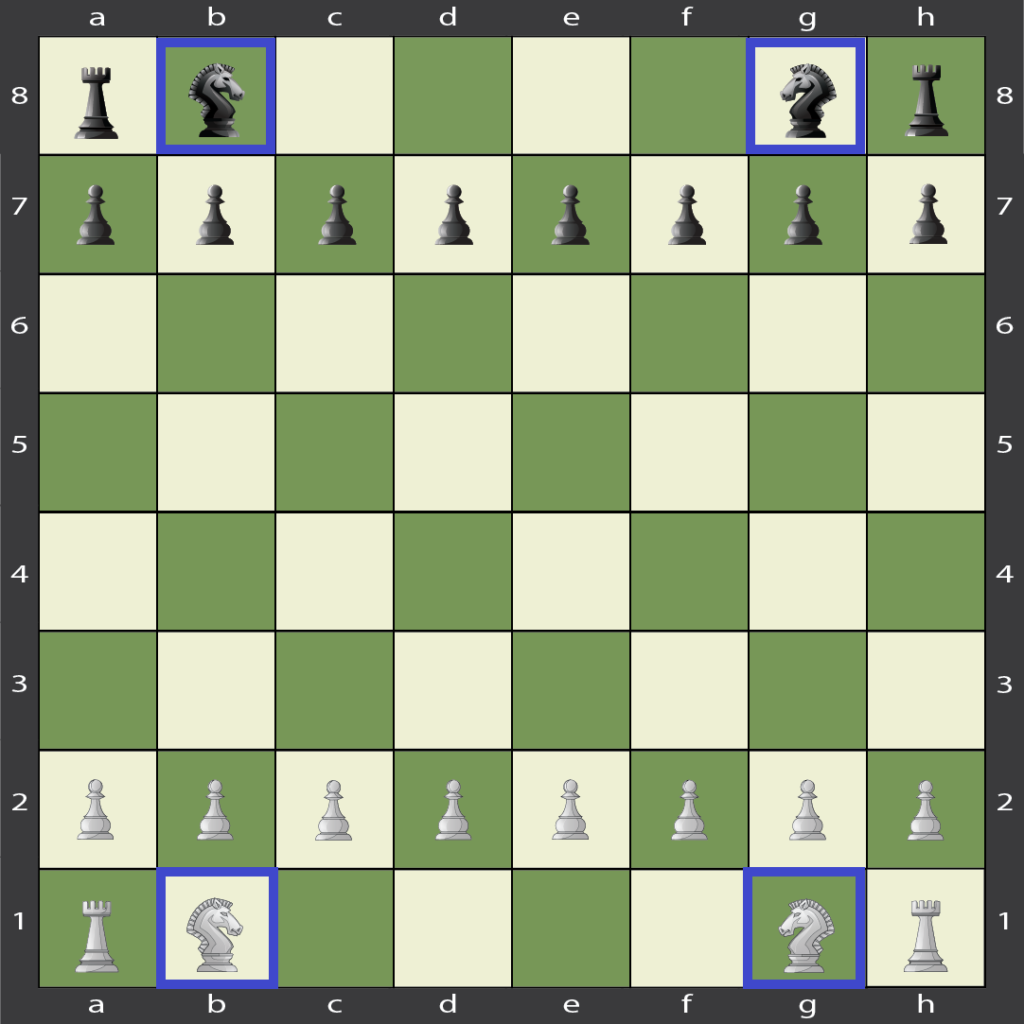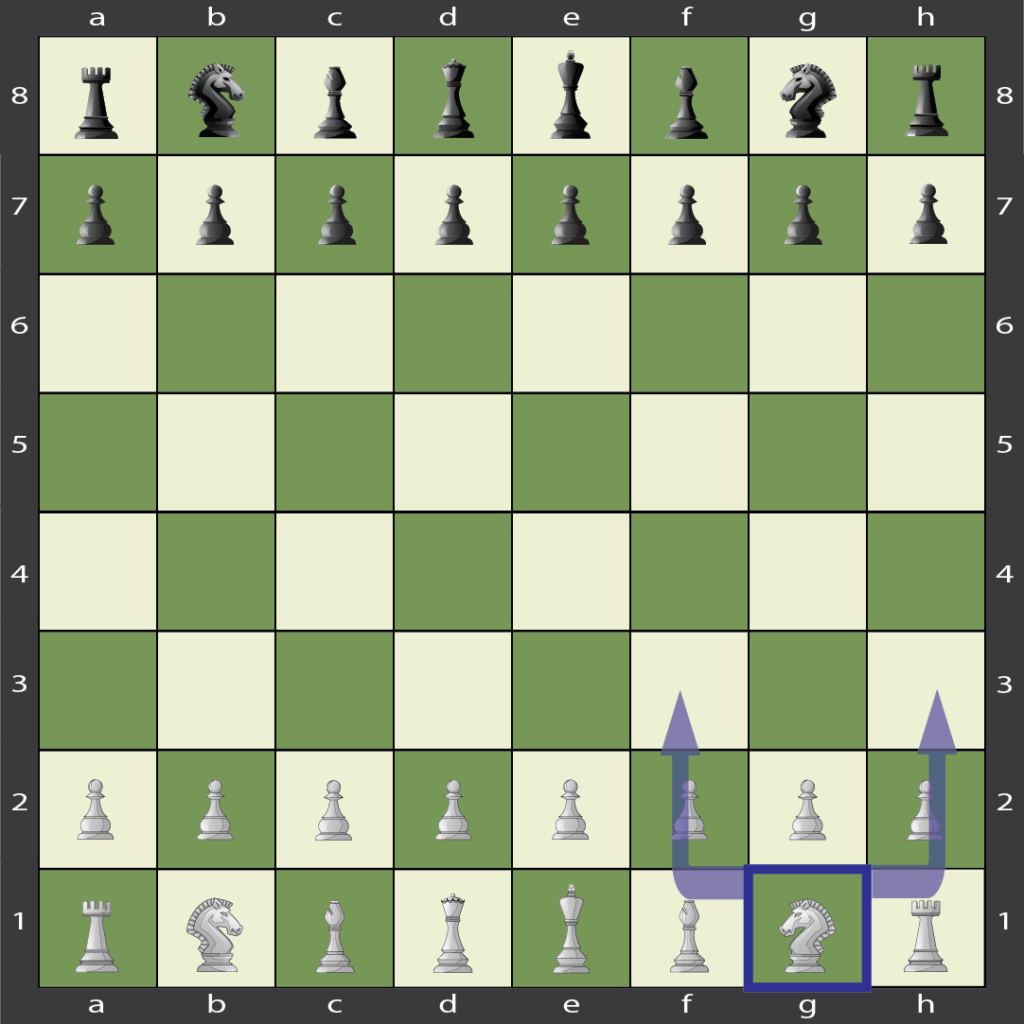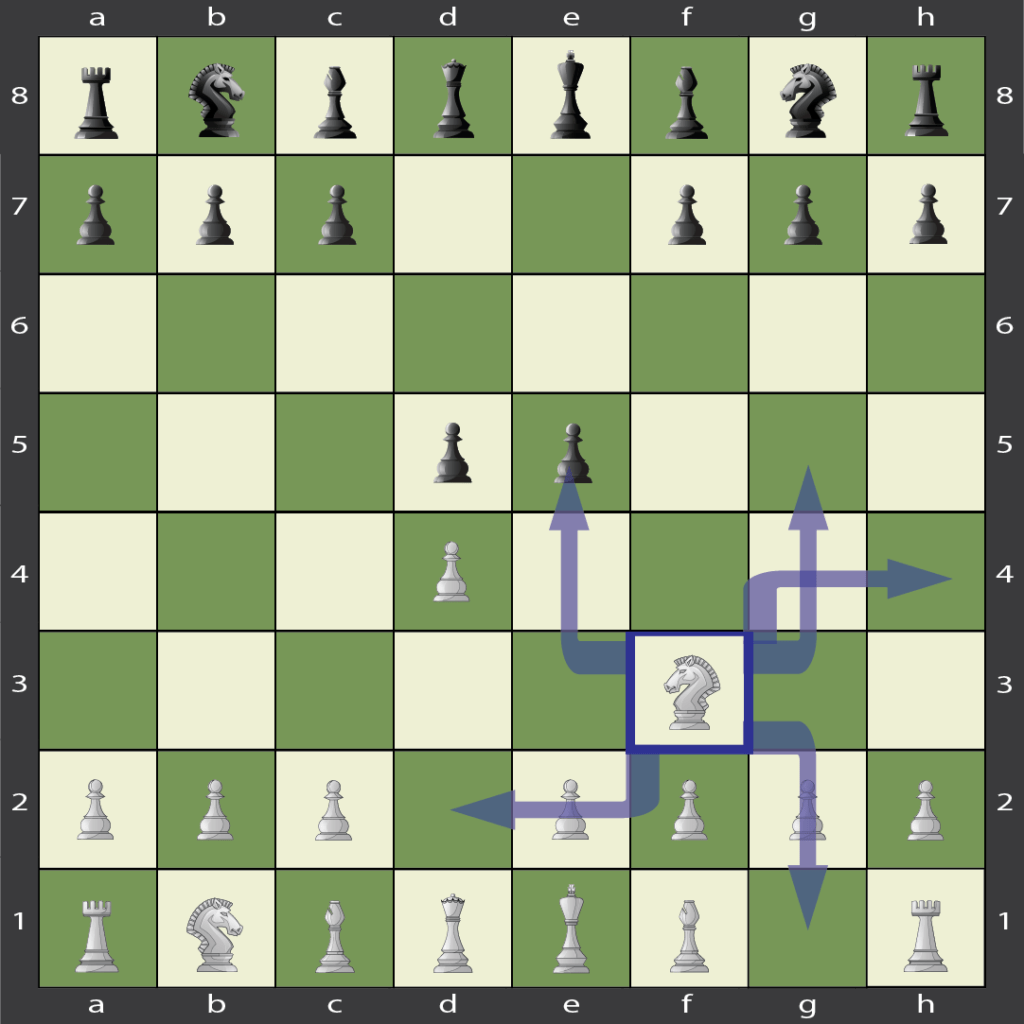
The knight chess piece, with its unique and captivating L-shaped movement, brings an aura of mystique and excitement to the chessboard. Unlike any other piece, the knight has the ability to leap over other chessmen, making it an unpredictable force in the game.
Table of Contents
The knight moves in an “L” pattern, two squares in one direction and then one square perpendicularly. This characteristic grants the knight the capacity to sneak behind enemy lines, evade obstacles, and execute surprise attacks. Its unpredictability can catch opponents off guard, making it a formidable piece in both tactical assaults and defensive maneuvers.
Position of the Knight Chess Piece
A game of chess has a total of four nights on the board at the start of the game. The two white knights start the game on b1 and g1, while the two black knights begin on b8 and g8, respectively as you can see here:

At the start of the game, the four knights are surrounded by bishops, rooks, as well as pawns. Since the knight is the only piece that can jump over other pieces, it is also the only piece that can start the game immediately, without moving the pawns first.
A common beginner mistake is to swap bishops and knights in the starting position. Make sure your knights are always directly besides your rooks, which always occupy the corner-squares.
How the Knight Chess Piece Moves
The knight’s movement in an “L” pattern is often likened to a horse’s jump. The knight’s unique ability to change direction while moving distinguishes it from all other pieces. Here are some examples for you:

Knight chess piece in action:

As you can see the knight chess piece can be very powerful indeed offering many options of play on the board.
Value of the Knight Chess Piece
The knight has a value of roughly 3 pawns. In theory, that makes the knight and bishop worth about the same. However, there are certain positions where the knight excels. In closed positions, the knight is able to jump over blockades, whereas the bishop might be blocked in by a rigid pawn structure, rendering it almost useless.
The knight’s dual-color movement accentuates its versatility and adaptability to various positions on the board. Knights can control squares of the opposite color from their starting position, enabling them to influence vast portions of the chessboard. A knight’s strategic prowess shines best in closed or complex positions, where its ability to hop over pieces proves invaluable.
In the hands of a skillful player, the knight can dance across the board with grace and precision, creating elegant tactical combinations and securing critical advantages. Its distinctive characteristics, combined with its potential to become a significant force in the endgame, render the knight a symbol of finesse and imaginative play. From daring knight forks to the mesmerizing beauty of a knight’s tour, this enigmatic piece captures the hearts of chess enthusiasts, adding a touch of wonder and enchantment to the age-old game of chess.
Knight Chess Piece: Further reading
The knight is considered a minor piece, alongside the bishop. In chess notation, the knight is indicated with the letter N.
Origin and Influence
The knight chess piece with its unique movement is believed to have originated from the way horse-mounted cavalry units moved on the battlefield during medieval times. Chess itself is believed to have been inspired by military tactics and warfare, with pieces representing different elements of an army.
In Arabic chess texts, the knight is referred to as the “horse.” The Arabic influence on chess during the Islamic Golden Age played a significant role in the game’s development and dissemination.
In early chess variants, the knight was often considered one of the most valuable pieces on the board due to its ability to swiftly cover long distances and leap over other pieces. It was considered essential for controlling the center of the board and mounting powerful attacks.
The Knight’s Tour
The “knight’s tour” is a classic chess puzzle where the objective is to move a knight to every square on the board exactly once, ending on any square. The knight’s tour has fascinated mathematicians and chess enthusiasts alike for centuries.
The Knight’s Fork
One of the knight’s most powerful tactical weapons is the “knight fork“, where it simultaneously attacks two or more enemy pieces at once. This tactic often results in gaining material or delivering a decisive blow to the opponent’s position.
Knight Chess Piece for Opening and Endgame
Many famous chess games and combinations involve the knight’s distinctive moves. Master players have utilized the knight’s capabilities to create stunning tactical masterpieces on the board.
The knight’s versatility allows it to be equally valuable in the opening, middlegame, and endgame. In closed positions, where other pieces may struggle, the knight often finds its true strength.
The knight’s fascinating movement and its historical association with cavalry tactics make it a compelling and enigmatic piece in the game of chess. Its versatility and ability to create unexpected threats and opportunities have made it a favorite among players throughout the centuries. The knight’s charm and complexity continue to enchant chess enthusiasts, cementing its place as a symbol of strategic finesse and imaginative play on the chessboard.
Affiliate Disclosure
Some of the links on Chesspert.com are affiliate links. This means that we may earn a small commission if you click through and make a purchase, at no additional cost to you. Please note that our product reviews and roundups are independent, and the affiliate relationships do not influence our content in any way.
Chesspert.com is a participant in the Amazon Services LLC Associates Program, an affiliate advertising program designed to provide a means for sites to earn advertising fees by advertising and linking to Amazon.com.
Chesspert.com is also a participant in the GammonVillage Inc. Affiliate Program, an affiliate advertising program designed to provide a means for sites to earn advertising fees by advertising and linking to GammonVillage.com.
Amazon and the Amazon logo are trademarks of Amazon.com, Inc. or its affiliates. GammonVillage is a trademark of GammonVillage Inc. or its affiliates.
Our passion for board games extends far beyond the chess table. We’ll be your trusted companion, on a journey through the enchanting realms of not only chess but also backgammon, dominoes, mahjong, checkers, and a diverse array of other captivating board games.
Whether you’re in search of the ideal chess set, luxury backgammon sets, a chinese checkers set, a checkers set, or if you’re seeking the excitement of a thrilling game of mahjong solitaire, we’ll guide you along the way.
In partnership with our affiliates, we bring you an extensive selection of board games and past times to explore and enjoy.
Dive into our extensive collection of guides and reviews, and unlock the joy and exhilaration that board games offer. From exquisitely crafted game pieces to the essential accessories that elevate your gaming experience, we’re here to guide you through it all with ease and delight.
Join us in celebrating the timeless allure and camaraderie that these games nurture, one post at a time!





